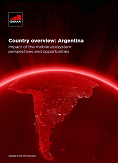Country overview: Argentina - Impact of the mobile ecosystem: perspectives and opportunities

Please complete the form below or register for a free public account to access this report.
Report details
Country overview: Argentina - Impact of the mobile ecosystem: perspectives and opportunities
GSMA Intelligence is today publishing the sixth in our country overview series, following Sri Lanka, Peru, Nigeria, Bangladesh and Philippines, in which we take a deep dive into the mobile market of Argentina and a closer look at the innovation ecosystem taking shape there.
Argentina is the third largest mobile market in Latin America, with 61 million mobile connections and 39 million unique subscribers, equating to 90% of the Argentine population.
The mobile market in Argentina is quickly transitioning towards saturation on a penetration basis as mobile ownership rates approach a ceiling of the addressable population. However, significant barriers exist to mobile technology achieving its full potential for society.
In this report we look at the story so far for Argentina’s mobile market and the key barriers to internet adoption. We examine how the country accounts for four of the six ‘unicorns’ in Latin America, helping put the country on the map and catalysing a wave of entrepreneurialism across a range of verticals. Finally we look at the role that the mobile sector is set to play in future economic growth in the country. The arrival of a new administration in December 2015 offers the promise of a change in the policy environment and presents a unique opportunity to create a new regulatory framework focused on convergent services, better reflecting the digital ecosystem.
Download the Report
Complete the form below to get instant access to this report. For easier access in the future, you can register for a free account here.
Report details
Country overview: Argentina - Impact of the mobile ecosystem: perspectives and opportunities
Related research
5G and network transformation: five trends to watch in 2026
How will the industry evolve in 2026? This series of reports highlights the key trends to watch and the implications for ecosystem players. This report examines 5G and network transformation.
GSMA Open Gateway: State of the Market, H2 2025
In the latest edition of the GSMA Open Gateway research series, key developments for H2 2025 include the segmentation of industry demand, and the continued deployment of APIs in categories other than fraud and security. The report provides an update on the state of the market, recent developments and examples of GSMA Open Gateway in action.
Network Transformation 2026
In GSMA Intelligence’s seventh annual survey of network technology executives, one data point stands out: 85% of operators claim opex efficiencies as a priority business objective for deploying AI in their networks.
Authors
How to access this report
Annual subscription: Subscribe to our research modules for comprehensive access to more than 200 reports per year.
Enquire about subscriptionContact our research team
Get in touch with us to find out more about our research topics and analysis.
Contact our research teamMedia
To cite our research, please see our citation policy in our Terms of Use, or contact our Media team for more information.
Learn moreRelated research
5G and network transformation: five trends to watch in 2026
How will the industry evolve in 2026? This series of reports highlights the key trends to watch and the implications for ecosystem players. This report examines 5G and network transformation.
GSMA Open Gateway: State of the Market, H2 2025
In the latest edition of the GSMA Open Gateway research series, key developments for H2 2025 include the segmentation of industry demand, and the continued deployment of APIs in categories other than fraud and security. The report provides an update on the state of the market, recent developments and examples of GSMA Open Gateway in action.
Network Transformation 2026
In GSMA Intelligence’s seventh annual survey of network technology executives, one data point stands out: 85% of operators claim opex efficiencies as a priority business objective for deploying AI in their networks.
- 200 reports a year
- 50 million data points
- Over 350 metrics
